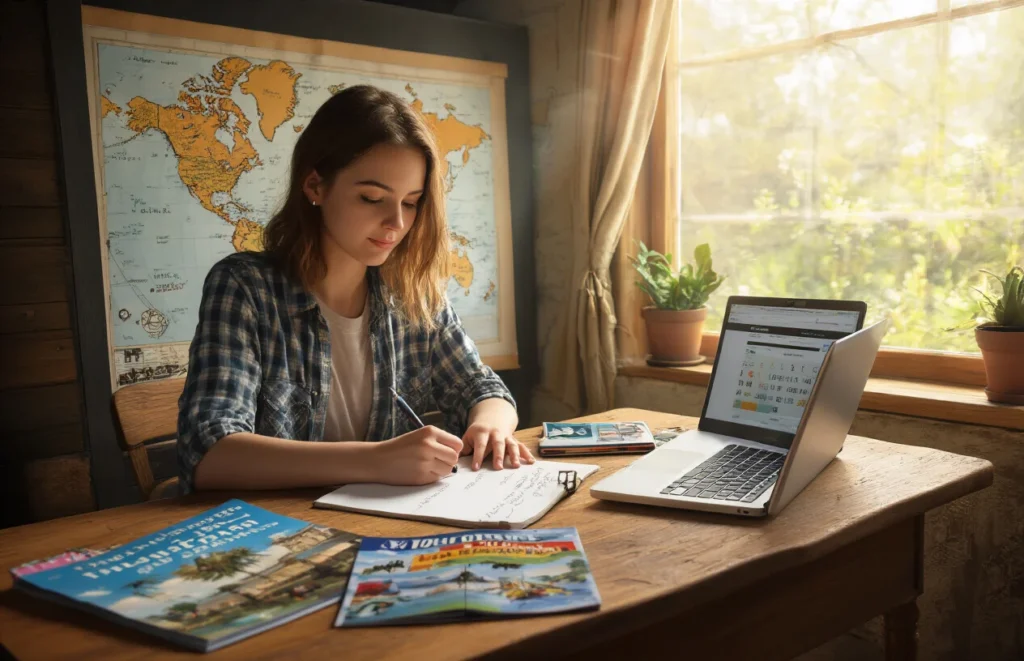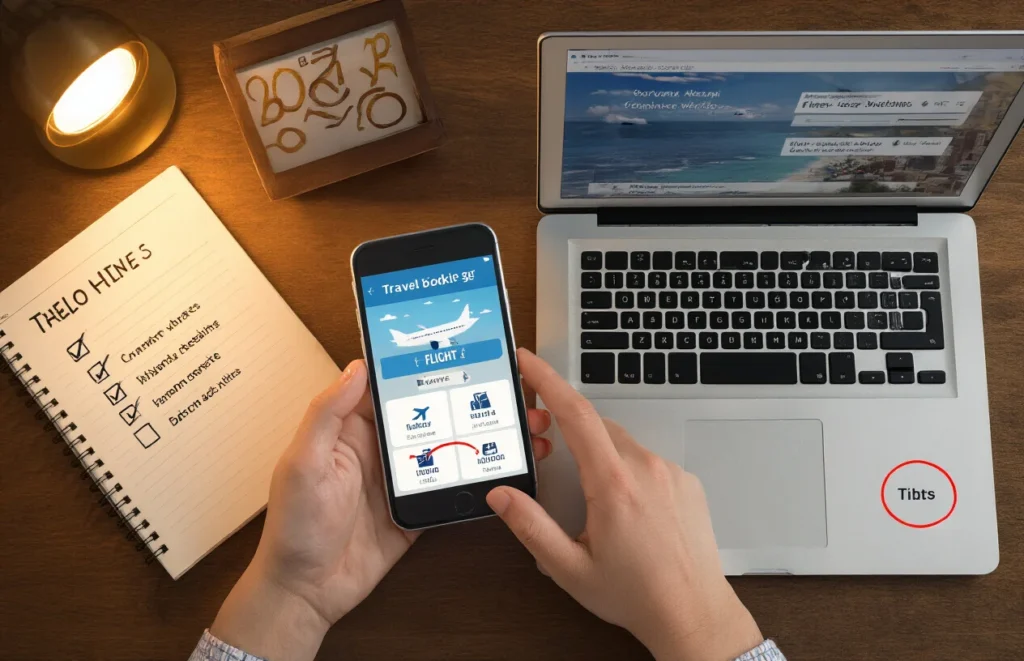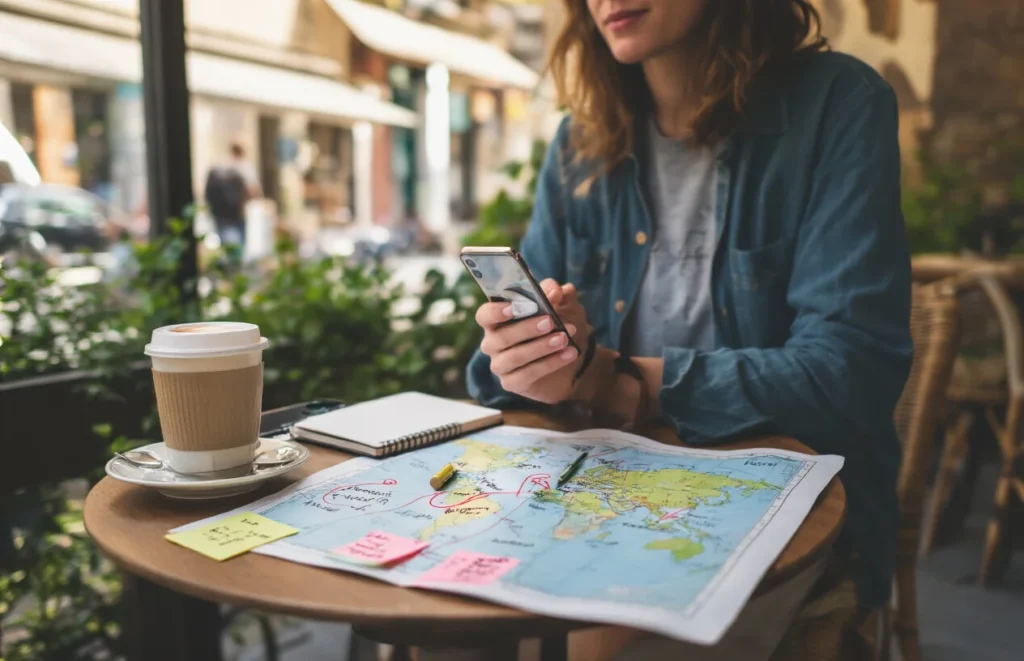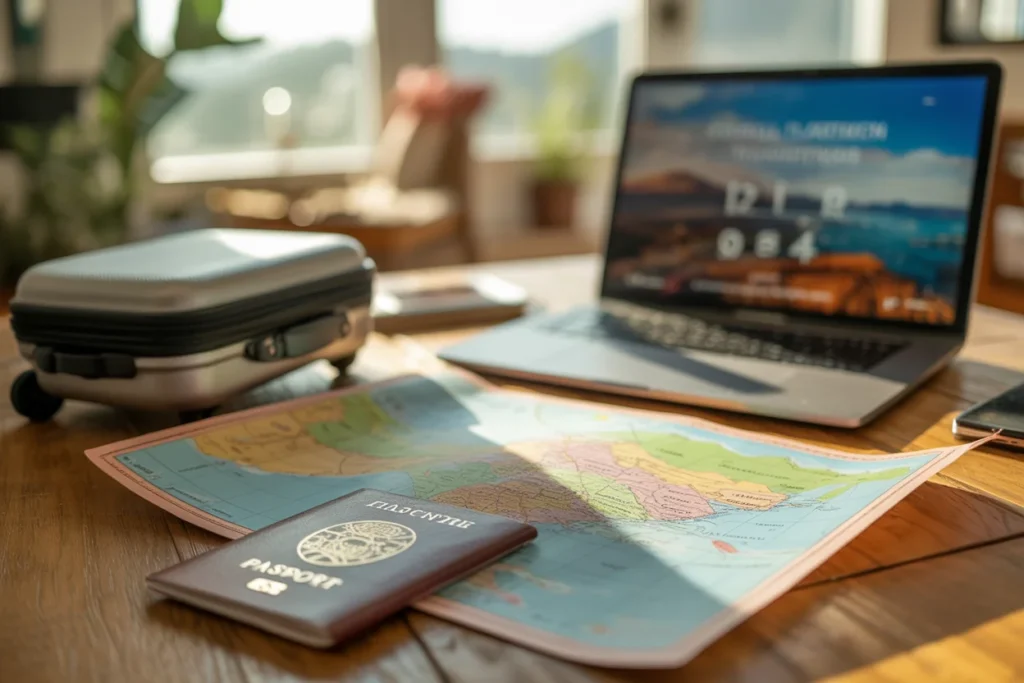Ever stared at your phone scrolling through Instagram Vacation pics, wondering why everyone else seems
to have the secret formula for epic trips? Yeah, I’ve been there too. Drowning in browser tabs,
comparison anxiety, and destination FOMO.
Let me save you hours of frustration with this beginner’s guide to planning the perfect vacation that
actually delivers on those picture-perfect expectations.
The truth is, memorable trips don’t happen by accident. They require smart planning that balances
structure with spontaneity – something I learned after botching my first three international adventures.
What separates dream vacations from travel nightmares isn’t just the destination or your budget. It’s
about understanding a simple framework that travel pros use but rarely share with the rest of us.
Ready to discover what makes some travelers return home refreshed, while others need a vacation from
their vacation?
Define Your Dream Vacation

Ever noticed how some people come back from beach vacations complaining they were bored, while
others return from city tours exhausted? That’s because they ignored their travel style.
Are you a beach bum who’s happiest with sand between your toes? An adventure junkie craving
adrenaline rushes? Or a culture vulture who could spend days in museums?
Think about your perfect day. Would it include:
Hiking up mountains or lounging by pools?
Street food adventures or five-star dining?
Guided tours or wandering solo?
Your answers reveal what you actually want, not what Instagram tells you to want.Set Realistic Budget Expectations
Money talk isn’t fun, but neither is running out of cash halfway through your trip.
Break down your budget into:
Transportation (flights, trains, taxis)
Accommodation (hotels, hostels, rentals)
Food and drinks
Activities and entertainment
Shopping and souvenirs
Emergency fund (always have one!)
A budget-friendly hostel trip to Southeast Asia might cost $30-50/day, while a luxury European vacation
could run $300+/day. Be honest about what you can afford.
Choose the Best Time to Travel
Timing can make or break your vacation. Consider:
| Factor | Why It Matters |
| Weather | Rain seasons can ruin beach plans |
| Crowds | Peak season means longer lines, higher prices |
| Local events | Festivals can be highlights or headaches |
| Work schedule | Taking time when you’re least stressed |
Research “shoulder seasons” – those sweet spots just before or after peak times when the weather’s still good but crowds have thinned.
Determine Trip Duration for Maximum Enjoyment
Longer isn’t always better. A well-planned week can be more satisfying than a dragging month.
For city breaks, 3-5 days usually hits the sweet spot. Beach vacations need at least 4-7 days to truly
unwind. Multi-destination trips? Allow 2-3 days per location minimum.
Consider travel fatigue – constantly packing/unpacking and moving around gets old quickly. And
remember that the first and last days often get consumed by travel logistics.
Research Your Destination

A. Explore Popular Attractions and Hidden Gems
Ever notice how some travelers come back with stories nobody else has? That’s because they didn’t just
hit the Eiffel Tower or Times Square.
Start by making a list of the must-see spots. Yeah, seeing the Colosseum in Rome is touristy, but it’s
popular for a reason. But don’t stop there.
Dig deeper. Check travel forums like Reddit’s r/travel or Lonely Planet’s Thorn Tree. People love sharing
those special spots that don’t make it into the guidebooks.
Talk to friends who’ve been there. Their mistakes and discoveries are gold.
And here’s a trick the seasoned travelers use: follow local food bloggers on Instagram before your trip.
They’ll lead you to neighborhoods tourists rarely find.
B. Understand Local Culture and Customs
Nothing screams “tourist” like accidentally insulting the locals.
Quick research saves embarrassment. In Japan, tipping is considered rude. In Thailand, never touch
someone’s head. In Turkey, a thumbs-up isn’t always positive.Learn a few basic phrases. Even just “hello,” “please,” and “thank you” in the local language opens
doors.
Dress codes matter too. That tank top might be comfy, but it could prevent you from entering religious
sites in many countries.
Meal times differ globally. Dinner at 6 PM works in America but shows up to a Spanish restaurant then
and you’ll be eating alone.
C. Check Visa Requirements and Travel Advisories
The fastest way to ruin your vacation? Being turned away at the border.
Check visa requirements months ahead. Some countries offer visa-on-arrival, others need applications
weeks in advance. And remember, passport validity requirements vary—many countries demand six
months remaining beyond your trip dates.
Government travel advisories aren’t just boring bureaucracy. They contain crucial info about political
unrest, natural disasters, and crime hotspots.
Make copies of important documents. One in your luggage, one with someone at home, and digital
copies in your email.
Travel insurance isn’t just for paranoid people. It’s for smart ones who know a broken leg in a foreign
country can cost more than the vacation itself.
D. Research Weather Patterns and Pack Accordingly
Packing shorts for rainy season? Good luck with that.
Weather apps aren’t enough. Research historical weather patterns for your destination during your
specific travel dates.
Remember that seasons are reversed in the Southern Hemisphere. December in Australia means
sunscreen, not snow boots.
Even tropical paradises have temperature swings. Bali nights can get chilly, despite the daytime heat.
Layers are your best friend. They take up less space than bulky items and give you flexibility.
Pack for your activities, not just the weather. Hiking boots for city tours? Your feet will hate you by day
two.
E. Find Authentic Local Experiences
Tourist traps are easy to spot once you know what to look for.
Skip restaurants with menus in five languages. That “authentic” show with the tour bus parking lot?Probably not so authentic.
Instead, find where the locals actually hang out. Apps like Google Maps now show popular times for
locals versus tourists.
Consider homestays over hotels. Nothing beats learning to make pasta from an Italian grandmother.
Take public transportation when safe. You’ll save money and see how locals really live.
Cooking classes, local festivals, and neighborhood markets give you stories worth telling. That’s the
difference between visiting a place and experiencing it.
Master the Art of Booking

A. Compare Flight Options for Best Deals
Booking flights can eat up half your vacation budget if you’re not careful. Truth is, flight prices jump
around like crazy. One day they’re affordable, the next they’re highway robbery.
Start by using flight comparison tools like Google Flights, Skyscanner, or Kayak. These guys show you
prices across multiple airlines at once. Toggle between nearby airports too – sometimes flying into a
smaller airport 30 minutes away can save hundreds.Timing matters big time. Tuesdays and Wednesdays are typically cheaper for booking. And that sweet
spot? About 6-8 weeks before domestic trips and 3-5 months before international ones.
B. Choose Accommodations That Match Your Needs
Hotels aren’t your only option anymore. Ask yourself what actually matters to you:
Need a kitchen? Grab an Airbnb or apart-hotel
Want local vibes? Try a guesthouse or B&B
Traveling solo? Hostels offer social spaces to meet people
Got kids? Look for places with pools or kid-friendly amenities
Location trumps luxury most times. A basic room in the perfect spot beats a fancy hotel that’s
inconvenient.
C. Consider Transportation Between Destinations
Getting from point A to B can make or break your trip. Public transport is usually cheapest but eats up
time. Rental cars give freedom but add parking headaches and costs.
In Europe? Check train passes. In Southeast Asia? Look at budget airlines for hops between countries.
Always factor in transfer times between airports/stations and your actual accommodations. That $30 you
saved might cost you a 2-hour commute.
D. Decide Between Guided Tours or Independent Travel
This comes down to your personality and the destination. Guided tours handle all the logistics and give
you insider access. They’re perfect for places with language barriers or complex logistics.
Going independent gives you total freedom to change plans on a whim. Want to stay an extra day
because you found an amazing local spot? No problem.
Mix and match when it makes sense. Book guided day tours for the complex stuff, then explore
independently the rest of the time.
Create a Flexible Itinerary

A. Balance Activities with Relaxation Time
The quickest way to ruin a vacation? Cramming too much into each day. I’ve seen it happen—folks
running from one attraction to another, checking things off their list but missing the whole point of getting
away.
Your vacation isn’t a race. For each busy day of sightseeing or adventure, build in a chill day or at least a
few hours of downtime. Maybe that’s lounging by the pool, people-watching at a café, or simply sleeping
in.
Remember: exhaustion isn’t a souvenir worth bringing home.
B. Group Sights by Location to Save Time
Smart travelers don’t zigzag across town. They cluster activities by neighborhood or area.
Want to see how this works? Look at your destination map and group attractions that are within walking
distance of each other. You’ll slash transit time and squeeze more enjoyment from each day.
Example for Paris:
Morning: Louvre MuseumLunch: Café near Tuileries Garden
Afternoon: Stroll through Tuileries to Place de la Concorde
Evening: Champs-Élysées
C. Leave Room for Spontaneous Adventures
The magic of travel often happens when you ditch the plan. That hidden beach your server mentions?
The street festival you stumble upon? These unplanned moments become your favorite stories.
Don’t schedule every minute. Leave half-days or even full days completely open. Your future self will
thank you when you discover something amazing that wasn’t in the guidebook.
D. Plan for Rainy Day Alternatives
Weather can throw a wrench in even the best vacation plans. But prepared travelers have backup
options ready.
For every outdoor activity, have an indoor alternative in your back pocket:
Beach day → Local museum or cooking class
Hiking → Shopping district or spa visit
Outdoor tour → Historical site or art gallery
Prepare for a Stress-Free Journey

A. Organize Important Documents
Nothing kills vacation vibes faster than realizing your passport expired last month. Trust me, I’ve seen
grown adults cry at airport check-in counters.
Make a simple checklist of must-have documents:
Passport (valid for at least 6 months beyond your trip)
Visa paperwork (if needed)
Flight confirmations and boarding passes
Hotel/accommodation bookings
Travel insurance policy
Driver’s license or international driving permit
Vaccination records (especially important these days)Take photos of everything and email them to yourself. Then make physical copies too. Keep one set in
your carry-on and another separate from your originals. Paranoid? Maybe. But you’ll thank me when
your bag gets stolen in Barcelona.
B. Set Up International Phone and Payment Options
The days of travelers’ checks are long gone. Call your bank before leaving and tell them where you’re
headed. Nothing screams “vacation disaster” like your card getting frozen because your bank thinks
someone stole it.
For your phone, you’ve got options:
International roaming plan with your current carrier
Local SIM card upon arrival (usually cheapest)
eSIM services like Airalo or Holafly
Portable WiFi device rental
Download offline maps, translation apps, and banking apps before you go. Your future self, wandering
lost without data in Tokyo, will be eternally grateful.
C. Learn Essential Phrases in the Local Language
You don’t need to become fluent in Finnish before your trip, but knowing a few key phrases goes a long
way.
Start with these basics:
Hello/Goodbye
Please/Thank you
Yes/No
Excuse me
I don’t understandWhere is the bathroom?
Help!
I’m allergic to…
Most locals appreciate the effort even if your pronunciation is horrible. They’ll often switch to English, but
that initial attempt shows respect for their culture.
D. Pack Smartly with Travel Essentials
Overpacking is the rookie mistake we’ve all made. That extra pair of shoes you “might need” will mock
you as you drag your overweight suitcase up five flights of stairs in your charming (but elevator-less)
European hotel.
Pack clothes that:
Layer easily
Dry quickly
Mix and match
Don’t wrinkle horribly
Don’t forget these non-clothing essentials:
Universal power adapter
Portable charger
Basic medications
Small first-aid kit
Reusable water bottleEye mask and earplugs
E. Prepare Your Home for Your Absence
The last thing you want while sipping cocktails on the beach is worrying if you left the stove on.
Before leaving:
Stop mail and newspaper delivery
Set lights on timers
Unplug non-essential electronics
Adjust thermostat
Clean out the refrigerator
Take out all trash
Lock all windows and doors
Ask a neighbor to keep an eye out
Consider a video doorbell system if you’re gone for an extended period. They’re relatively inexpensive
now and give you peace of mind when your phone alerts you to package deliveries rather than potential
break-ins.
Planning the perfect vacation doesn’t have to be overwhelming. By defining your dream vacation goals,
researching your destination thoroughly, and mastering the booking process, you’ve already set yourself
up for success. Creating a flexible itinerary and preparing ahead for a stress-free journey are the final
pieces that transform a simple trip into an unforgettable experience.
Now it’s time to put these vacation planning skills into action. Start dreaming about your next destination
today, and remember that the perfect vacation isn’t about having everything go exactly as planned—it’s
about creating meaningful memories while navigating the adventure with confidence. Happy travels!
Planning your dream vacation is just the beginning! 🌍
For more travel tips, destination guides, and expert planning advice, check out our blog page.
Stay inspired and follow our journey on social media:
📸 Instagram | 👍 Facebook | 🐦 Twitter/X | 📌 Pinterest
Have questions or want personalized travel tips? Contact us here — we’d love to help you plan your next adventure!


